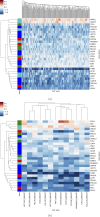Bottom-up, integrated -omics analysis identifies broadly dosage-sensitive genes in breast cancer samples from TCGA
- PMID: 30653567
- PMCID: PMC6336338
- DOI: 10.1371/journal.pone.0210910
Bottom-up, integrated -omics analysis identifies broadly dosage-sensitive genes in breast cancer samples from TCGA
Abstract
The massive genomic data from The Cancer Genome Atlas (TCGA), including proteomics data from Clinical Proteomic Tumor Analysis Consortium (CPTAC), provides a unique opportunity to study cancer systematically. While most observations are made from a single type of genomics data, we apply big data analytics and systems biology approaches by simultaneously analyzing DNA amplification, mRNA and protein abundance. Using multiple genomic profiles, we have discovered widespread dosage compensation for the extensive aneuploidy observed in TCGA breast cancer samples. We do identify 11 genes that show strong correlation across all features (DNA/mRNA/protein) analogous to that of the well-known oncogene HER2 (ERBB2). These genes are generally less well-characterized regarding their role in cancer and we advocate their further study. We also discover that shRNA knockdown of these genes has an impact on cancer cell growth, suggesting a vulnerability that could be used for cancer therapy. Our study shows the advantages of systematic big data methodologies and also provides future research directions.
Conflict of interest statement
We have the following interests. BDK and TND are employed by Eli Lilly. This research project is independent from Eli Lilly, but as a part of the Ph.D. dissertation project of Bobak, the first author. There are no patents, marketed products, or products in development due to the affiliation with Eli Lilly and this affiliation does not alter our adherence to all PLOS ONE policies on sharing data and materials.
Figures




Similar articles
-
LinkedOmics: analyzing multi-omics data within and across 32 cancer types.Nucleic Acids Res. 2018 Jan 4;46(D1):D956-D963. doi: 10.1093/nar/gkx1090. Nucleic Acids Res. 2018. PMID: 29136207 Free PMC article.
-
Targets of genome copy number reduction in primary breast cancers identified by integrative genomics.Genes Chromosomes Cancer. 2007 Mar;46(3):288-301. doi: 10.1002/gcc.20411. Genes Chromosomes Cancer. 2007. PMID: 17171680
-
Proteomic changes resulting from gene copy number variations in cancer cells.PLoS Genet. 2010 Sep 2;6(9):e1001090. doi: 10.1371/journal.pgen.1001090. PLoS Genet. 2010. PMID: 20824076 Free PMC article.
-
DNA amplifications in breast cancer: genotypic-phenotypic correlations.Future Oncol. 2010 Jun;6(6):967-84. doi: 10.2217/fon.10.56. Future Oncol. 2010. PMID: 20528234 Review.
-
Exploring cancer genomic data from the cancer genome atlas project.BMB Rep. 2016 Nov;49(11):607-611. doi: 10.5483/bmbrep.2016.49.11.145. BMB Rep. 2016. PMID: 27530686 Free PMC article. Review.
Cited by
-
Algorithms and tools for data-driven omics integration to achieve multilayer biological insights: a narrative review.J Transl Med. 2025 Apr 10;23(1):425. doi: 10.1186/s12967-025-06446-x. J Transl Med. 2025. PMID: 40211300 Free PMC article. Review.
-
Integrative Network Fusion: A Multi-Omics Approach in Molecular Profiling.Front Oncol. 2020 Jun 30;10:1065. doi: 10.3389/fonc.2020.01065. eCollection 2020. Front Oncol. 2020. PMID: 32714870 Free PMC article.
-
Integrative Analysis of Incongruous Cancer Genomics and Proteomics Datasets.Methods Mol Biol. 2021;2361:291-305. doi: 10.1007/978-1-0716-1641-3_17. Methods Mol Biol. 2021. PMID: 34236668
References
-
- O’Connor C. Chromosomal Abnormalities: Aneuploidies. Nat Educ. 2008;1: 172.
MeSH terms
Substances
LinkOut - more resources
Full Text Sources
Medical
Research Materials
Miscellaneous

